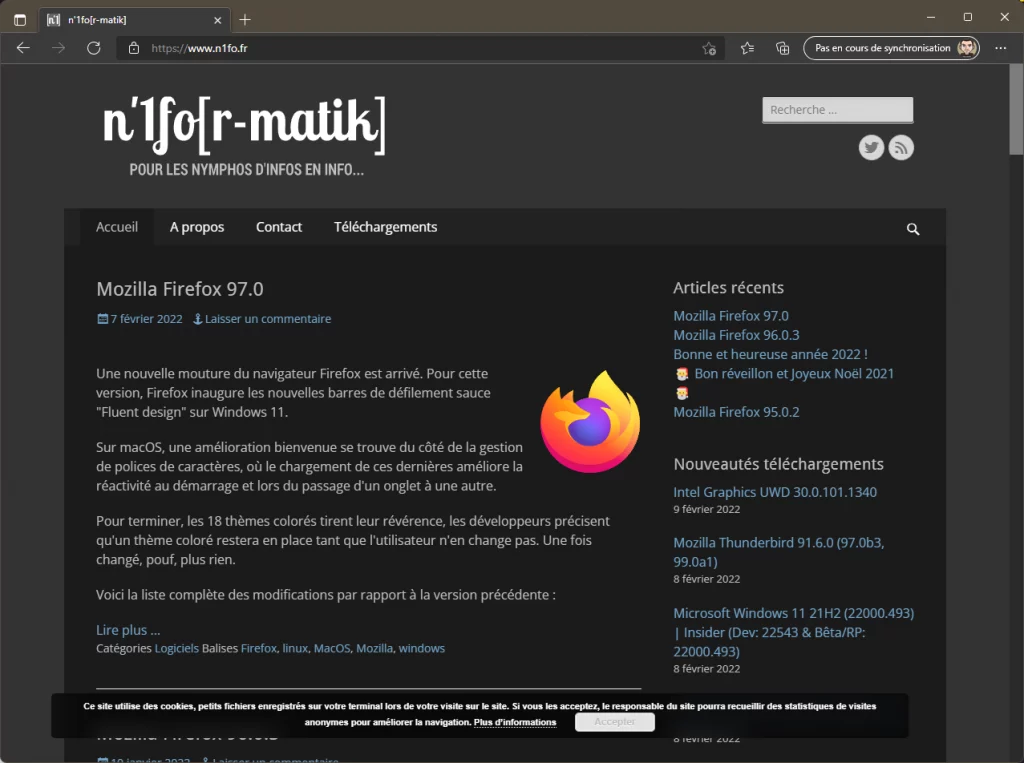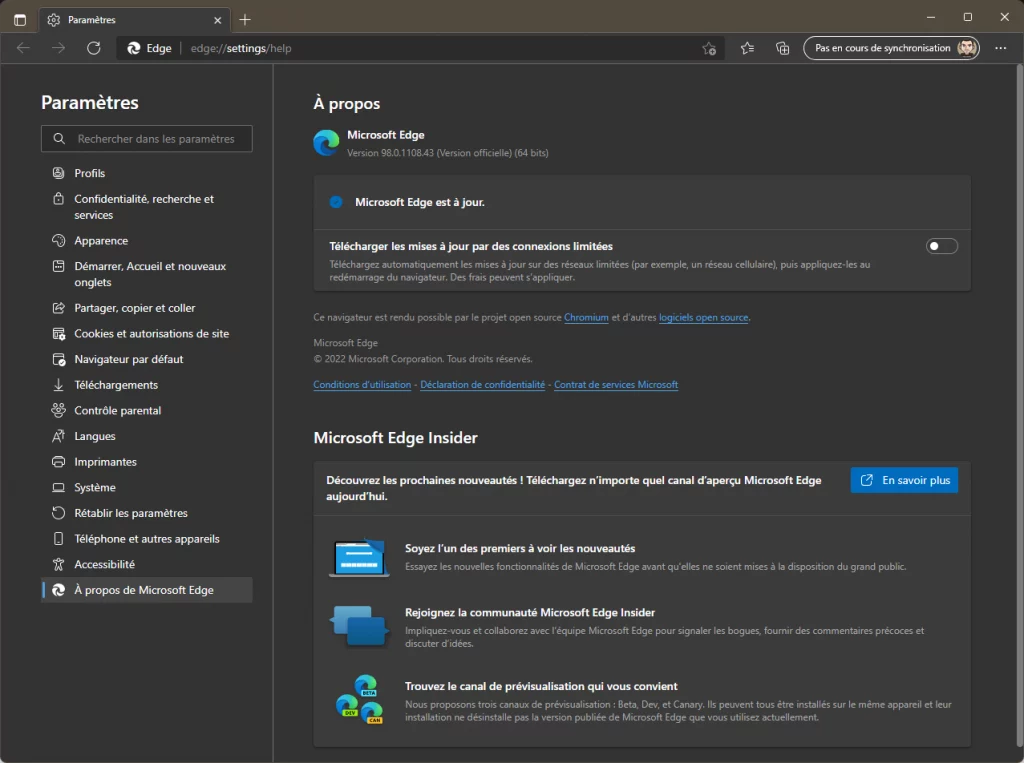Après avoir intégré Microsoft Edge au sein de Windows 10 sous forme de WindowsApps, Microsoft revient à la bonne vieille application classique (Win32 pour les intimes) et interopérable. En effet, le navigateur se transforme et abandonne le moteur maison pour embrasser Chromium.
Cela permet à Microsoft de proposer un clone de Chrome mais accentue son combat pour protéger la vie privée de son utilisateur en proposant un anti-traqueur en natif. Naturellement, toutes les fonctions de l'ancien Edge sont disponibles avec cette nouvelle mouture (synchronisation sur le compte Microsoft, extensions, etc...).
A noter qu'à partir de la version 94.0, le navigateur adoptera un cycle de sortie ramené à 4 semaines au lieu de 6 semaines…
Microsoft Edge
Version actuelle : 142.0.3595
[🇫🇷] Windows 64 bits & Server, macOS Intel/ARM, Linux DEB/RPM/Flatpak et Entreprises
Fixed various bugs and performance issues, feature updates, policy updates, and web platform release notes.
Stable channel security updates are listed here.
Announcements
- Important update regarding the rollout of the Auto-Open feature. We’ve identified an issue with the initial implementation of the Auto-Open feature—it didn’t fully respect user preferences, and some settings weren’t honored as intended.To address this, the changes are being rolled back in phases during the next month to ensure all user preferences are correctly honored. As a result, users may temporarily notice a return to previous behavior where the sidepane opens even if the sidebar visibility is set to Off.Here are a few ways to manage the auto-open experience:
- Manually Turn Off Auto-Open Pane: Users can manually disable the Auto-Open experience by navigating to the settings page if they prefer not to see the sidepane open for Outlook and Teams links.
- Automatic Engagement-Based Logic: If a user doesn't engage with the Auto-Open experience and quickly closes it three times in a row, the feature is automatically turned off.
- Turn off Auto-Open Pane using admin policies: Admins can control the Auto-Open experience by using either of these policies.
- HubsSidebarEnabled: Set as "False" to turn off
- ExtensionSettings: Set the sidebar_auto_open_blocked flag as "True" to turn off
Fixes
- Fixed an issue in headless mode which caused features like Print to PDF and Screenshot to not work as expected.
Feature updates
- Configuration update for MIP Enforcement. Starting in Microsoft Edge 142, new configuration step introduced to maintain MIP protections via Microsoft Edge management service. Existing settings remain active until admins choose to update. For more information, see Protect Office documents with Microsoft Purview Information Protection labeling.
- SmartScreen and Scareware blocker. In organizations where both Scareware blocker and SmartScreen are enabled, users will now have the option to send signals to SmartScreen. The new setting “Share detected scam sites with Microsoft Defender SmartScreen” is available under
edge://settings/privacy/security. If enabled, Scareware blocker will report its verdict to Microsoft Defender SmartScreen to enhance protection. Admins can control availability to this feature using the ScarewareBlockerSendDetectedSitesToSmartScreenEnabled policy. - New Scareware blocker policies. Introducing two new policies for admins to configure Scareware blocker. The first, ScarewareBlockerAllowListDomains, configures a list of trusted domains for Microsoft Edge Scareware blocker. When a website's source URL matches any domain in this list, Microsoft Edge Scareware blocker doesn't analyze that site. The second, ScarewareBlockerBlocksDetectedSitesEnabled, blocks sites that are detected as potential tech scams. For both of these new policies, they will only take effect if the ScarewareBlockerProtectionEnabled policy is enabled.
- Drag to group tabs. Tab groupings can be made by dragging a tab over another. This feature can now be controlled by the "Drag to group tabs" toggle in Microsoft Edge Settings
edge://settings/appearance/tabs. - Open external links in another profile when recommended by external applications. When Microsoft Edge is set as the default browser to open external links from applications, Microsoft Edge must determine which profile to open the links. Users can control which profile to use through the “Default profile for external links” setting. Applications such as Microsoft Teams or Outlook can also recommend a profile for the links. Currently, the user setting is prioritized over application recommendations. With this feature, the application recommended profile is given priority, instead of the profile selected in the setting. Admins can control the availability of the feature using the EdgeOpenExternalLinksWithAppSpecifiedProfile policy.
- Improved Autofill experience in Microsoft Edge. When users fill in an Address on a form, they will be prompted to choose whether to save it for future Autofill suggestions. This enhancement ensures Autofill data is saved intentionally by users and reduces unwanted entries as part of their Autofill suggestion. Note: This is a controlled feature rollout. If you don't see this feature, check back as we continue our rollout.
Versions en cours de développement
Microsoft Edge "Insider" Bêta
Version actuelle : 143.0 - Notes de version
[🇫🇷] Windows 10+ : 64 bits & Server, macOS Intel/ARM64 ou Linux DEB/RPM
Microsoft Edge "Insider" Dev
Version actuelle : 144.0
[🇫🇷] Windows 10+ : 64 bits & Server, macOS Intel/ARM64 ou Linux DEB/RPM/Flatpak
Microsoft Edge "Insider" Canary
Version actuelle : 144.0
[🇫🇷] Windows 10+ : 32 bits, 64 bits & Server ou macOS : Intel/ARM64
Ancienne version

